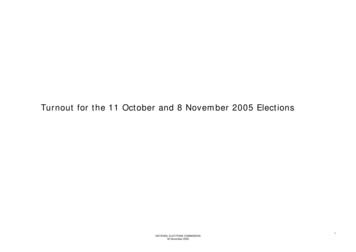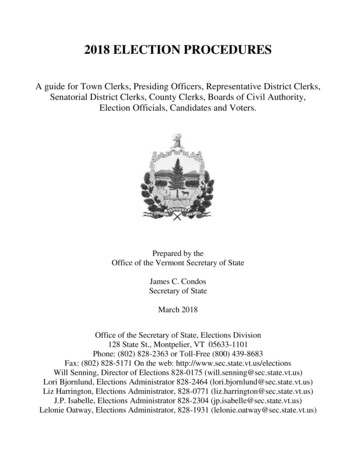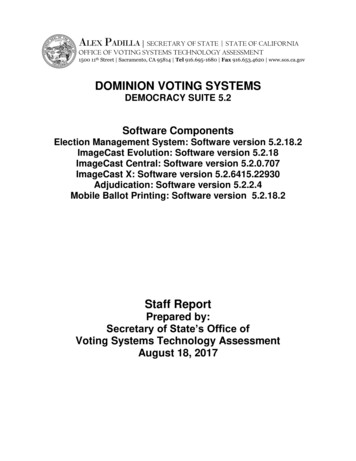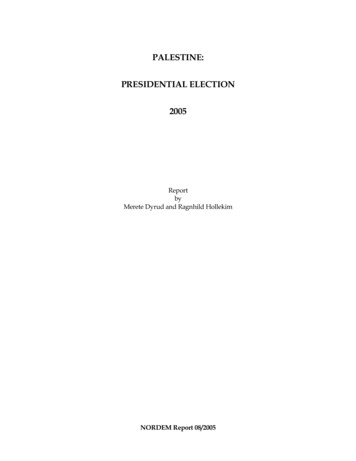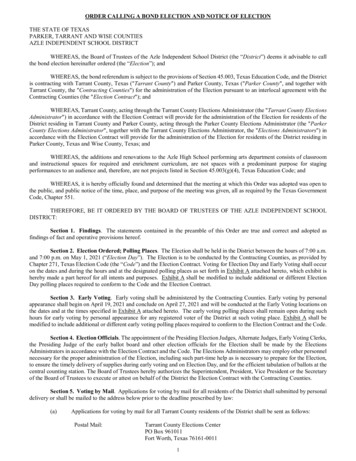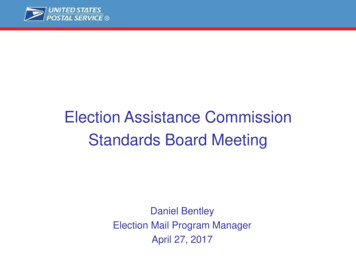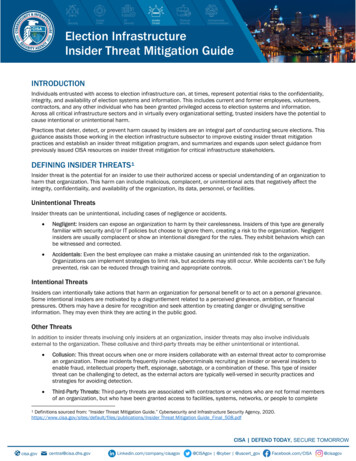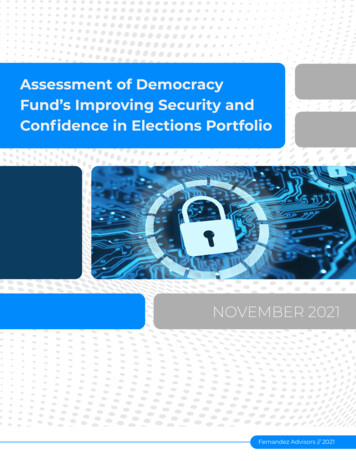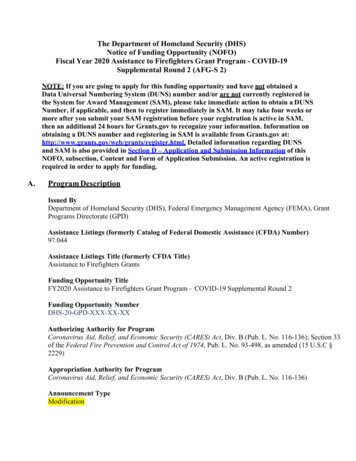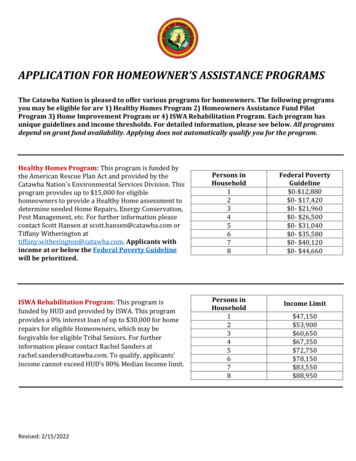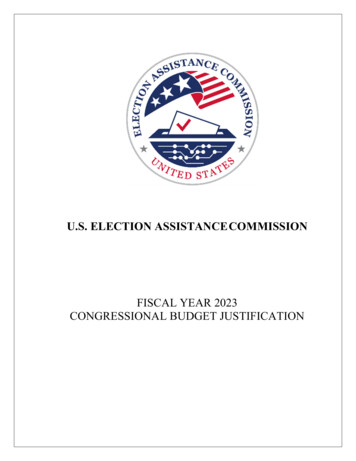
Transcription
U.S. ELECTION ASSISTANCE COMMISSIONFISCAL YEAR 2023CONGRESSIONAL BUDGET JUSTIFICATION
U.S. Election Assistance CommissionFiscal Year 2023 Congressional Budget JustificationTable of ContentsVision and Mission .3FY 2023 Priority Goals 3Appropriations Language .5Agency Background .6Goals and Structure .7Organizational Chart 8FY 2021 Accomplishment Highlights .9Operating Plan Summary . 15FY 2023 Budget Request Highlights . 17Budgetary Changes . 23Budget Requests and Performance Measures by Goal 24Attachment A – OIG Budget Request in Detail .322
U.S. Election Assistance CommissionFiscal Year 2023 Congressional Budget JustificationMission and VisionMissionThe U.S. Election Assistance Commission helps election officials improve the administration of electionsand helps Americans participate in the voting process.VisionThe U.S. Election Assistance Commission is a trusted, proactive, and responsive federal agency thathelps election officials administer and voters participate in elections.Salaries and ExpensesFY 2021EnactedFTE*46Dollars 17,000,000FY 2022President’s BudgetFTE65Dollars 22,833,531FY 2023RequestFTE78Dollars 30,087,000*FTE number for FY 2021 reflects current actual. FY 2022 number reflects President’s Budget request.FY 2023 reflects agency need as it relates to the requested PC&B figure.Election Innovation GrantsFY 2021EnactedFTE-Dollars-FY 2022President’s BudgetFTE-Dollars100,000,000FY 2023RequestFTE5Dollars 250,000,000FY 2023 Priorities-- Continue to serve as a clearinghouse of voting information by providing election officials and voterswith necessary and timely information and materials as they administer and participate in the 2022midterm election, as well as any elections after.-- Help the nation administer elections with secure and accessible voting systems by continuing toimplement the EAC’s most up-to-date Voluntary Voting System Guidelines (VVSG), as well as expandand strengthen the testing and certification of voting equipment via field auditors, election technologyspecialists, and a quality monitoring program of equipment after it leaves the manufacturer.-- Process, analyze, and release data from the 2022 Election Administration and Voting Survey (EAVS),the agency’s instrument used to collect state-by-state data on the administration of federal elections.Additionally, execute studies statutorily mandated by the Help America Vote Act of 2002 (HAVA) thathave sat idle due to years of insufficient funding.3
U.S. Election Assistance CommissionFiscal Year 2023 Congressional Budget Justification-- Make critical investments in advancing agency management and performance, as well as establishdedicated staff aimed at assisting states in complying with voting laws and civil rights voting laws as amatter of focusing on equity advancement.-- Expand a critically under-staffed Communications department while also furthering theadministration’s IT modernization agenda through website development and strong networkadministrators.-- Revamp the agency’s website to expand accessibility and usability, as well as modern tools to displaycritical data points, voter education material, and tools to assist all agency stakeholders.-- Administer a competitive Election Innovation Grant funding to states with qualified projects, ensuringfunding is utilized efficiently and that states in need of such funding have an opportunity to request it.4
U.S. Election Assistance CommissionFiscal Year 2023 Congressional Budget JustificationAppropriations languageU.S. Election Assistance CommissionSALARIES AND EXPENSES(INCLUDING TRANSFER OF FUNDS)For necessary expenses to carry out the Help America Vote Act of 2002 (Public Law 107-252), 30,087,000, of which 1,500,000 shall be made available to the National Institute of Standards andTechnology for election reform activities authorized under the Help America Vote Act of 2002.ELECTION INNOVATION GRANTS (appropriation language)For the establishment of a competitive grants program to foster innovation, enhance processes andprocedures, and improve the administration of federal elections, 250,000,000, to remain availablethrough September 30, 2024; of which not to exceed 2 percent shall remain available until September30, 2028, for the administration and oversight of grants awarded under this heading: Provided, That theElection Assistance Commission shall, consistent with the purposes of the Help America Vote Act of2002, award grants to States and eligible units of local government on a competitive basis for projectsthat will have significant national, regional, or local impact in the improvement of the administration offederal elections through innovation, including, but not limited to, election administration; cybersecurityand statistically valid risk-limiting audits; security of election officials and locations; accessibility forvoters, including those with disabilities and other specific access needs, and including vote-by-mail,voter education, language proficiency, usability, and voter technology; or other programs to enhance orreliably secure processes and procedures in administering federal elections without meaningfullyimpairing access: Provided further, That for purposes of this appropriation, the term State has themeaning given such term in section 901 of the Help America Vote Act of 2002 (52 U.S.C. 21141):Provided further, That for purposes of this appropriation, the Commonwealth of the Northern MarianaIslands shall be deemed to be a State: Provided further, That for purposes of this appropriation, aneligible unit of local government is defined as a unit of local government with responsibility for theadministration of Federal elections: Provided further, That a grant awarded under this heading shall befor an amount not greater than 10,000,000, and shall be available for obligation by the State or eligibleunit of local government through September 30, 2028: Provided further, That not more than 10 percentof the total amount of funds made available under this heading may be awarded to projects in a singleState.5
U.S. Election Assistance CommissionFiscal Year 2023 Congressional Budget JustificationAgency Background and StructureCongress established the U.S. Election Assistance Commission (EAC) to help election officialsimprove the administration of elections and help Americans participate in the voting process. Congresscharged the EAC with fulfilling its mission by administering a national election administrationclearinghouse that studies election administration practices, provides best practices to the nation, helpsvoters register to vote and participate in federal elections, manages federal standards for voting systems,tests and certifies voting systems to the national standard, and distributes congressionally appropriatedfunds to states for the improvement of election administration.The EAC consists of four presidentially appointed Commissioners, professional staff, and four FACAcommittees. The majority and minority party each have the authority to recommend two of the fourCommissioners who lead the agency, making the EAC a bipartisan commission by statutory mandate.The EAC’s three statutorily mandated FACA committees are the Board of Advisors, the StandardsBoard, and the Technical Guidelines Development Committee (TGDC). The three groups advise theagency and help develop the EAC’s national voting system testing and certification standard, theVoluntary Voting System Guidelines (VVSG).The Help America Vote Act (HAVA) dictates the membership of the three committees. The StandardsBoard is a 110-member board consisting of 55 state election officials (the 50 states, the District ofColumbia, American Samoa, Guam, Puerto Rico, and the Virgin Islands) selected by their respectivechief state election official, and 55 local election officials selected through a process supervised by thechief state election officials. The Board of Advisors consists of groups representing governors; mayors;state legislatures; secretaries of state; state election directors; county recorders, election officials andclerks; voter advocacy groups; federal agencies; and professionals in the fields of science andtechnology.The TGDC helps the EAC develop its Voluntary Voting System Guidelines. It is composed of 14members appointed jointly by EAC and the Director of the U.S. Department of Commerce’s NationalInstitute of Standards and Technology (NIST), who is the chairperson of TGDC.Additionally, the EAC established a fourth FACA Committee, the Local Leadership Council (LLC), in2021 to provide expert, unbiased analysis and recommendations to the EAC on local electionadministration topics. Membership in the LLC consists of 100 members with two members from eachstate who are currently or recently serving officers of each state’s local election official association.The first meeting of the LLC took place on December 10, 2021. the LLC also held its annual meeting inearly 2022.6
U.S. Election Assistance CommissionFiscal Year 2023 Congressional Budget JustificationGoals and Structure of Budget JustificationAs established and detailed in the EAC’s strategic plan, the EAC’s operations and offices are aligned toaddress the Commission’s congressional mandates to serve as a clearinghouse of information on voting;test and certify voting systems; administer and maintain the National Voter Registration Act (NVRA)voter registration form; assist states with administration of HAVA funds; and report to Congress onNVRA and Uniformed and Overseas Citizens Absentee Voting Act (UOCAVA) voting activity.The EAC’s current strategic plan sets forth three strategic goals and 10 strategic objectives. The threestrategic goals are as follows:1. Strengthen American elections through the development and implementation of responsive anddynamic voting system guidelines and cyber resources for election officials;2. Encourage improvements to election administration through the development and distribution ofresources that assist election officials in modernizing American elections; and3. Create operational excellence throughout agency management and programming.7
U.S. Election Assistance CommissionFiscal Year 2023 Congressional Budget JustificationU.S. Election Assistance Commission Organization Chart8
U.S. Election Assistance CommissionFiscal Year 2023 Congressional Budget JustificationFiscal Year 2021 Accomplishment HighlightsThe U.S. Election Assistance Commission (EAC) is a trusted, proactive, and responsive bipartisanfederal commission that helps election officials administer and voters participate in elections.Established by the Help America Vote Act of 2002 (HAVA), the EAC provides funds to stateelection offices to improve and strengthen security around federal elections, serves asthe nation’s clearinghouse for information on election administration, conducts the ElectionAdministration and Voting Survey (EAVS) and other studies, develops the Voluntary VotingSystem Guidelines (VVSG), accredits testing laboratories and certifies voting systems, andadministers the National Mail Voter Registration Form in accordance with the National VoterRegistration Act of 1993. From coast-to-coast, the EAC is providing services for state and localelection officials and the voters they serve. Among the EAC’s most notable accomplishmentsduring Fiscal Year 2021 are the following:HAVA GrantsIn 2018, it had been eight years since the EAC last received HAVA grant funding. Between 2018and 2020 the EAC received over 1.1 billion in grants funds. The grant funds did not come with anincrease in operations funding to support administration and oversight. The workload, however,was significantly greater especially as the CARES funds came with a 20-day reporting requirementfor grantees and a 23-day reporting requirement to Congress by the EAC after each primary andthe general election. The EAC pursued Paperwork Reduction Act (PRA) approval to ensure thatthe required reporting was standardized to the reduce reporting burden across grant recipients. Theagency implemented official mid-year reporting for all HAVA grants in Q3 of FY 2021. Multipletraining events were held to support the reporting requirements for CARES, and Federal Financialand Progress reporting for all HAVA grants. The emphasis of training at critical compliance pointsled to improved and increased reporting compliance. Grants staff reviewed over 700 financial andprogress reports in FY 2021 including the 56 CARES 20-day reports from the General Election.The Grants Office developed Frequently Asked Questions (FAQs), written guidance, and webinarsto train grantees on the use of CARES funding and Election Security funds. The team responded toa high volume of inquiries regarding allowable, allocable, reasonable, and necessary expendituresand funding activities.CARES funding was only available to states until December 31, 2020, to prevent, prepare for, andrespond to the coronavirus for the 2020 federal election cycle. Per HAVA, states have until March2022 to meet the matching requirements. To ensure any unexpended federal funds andunexpended federal interest is returned prior to closeout, the EAC stood up a debt collection andcloseout process for the CARES grant. Training was provided to grantees on the upcomingcloseout process and guidance was published to the EAC website. In FY 2021, half the expectedunexpended CARES funds were recovered ahead of the project end date of March 2022 and 21grants were closed.In Q3 FY 2021, the EAC decided to make the Grants program into a standalone office to reflectthe importance of the function at the agency. The Office of Grants Management now reportsdirectly to the Executive Director. Additional personnel changes included hiring a full-time Grants9
U.S. Election Assistance CommissionFiscal Year 2023 Congressional Budget JustificationSpecialist to oversee and support the increased grantmaking responsibilities for the agency andrecruiting a second Grants Management Specialist with a start date anticipated in FY 2022.In Q4, the EAC selected HHS’ GrantSolutions grants administration software as a service toimprove and automate its grants administration functions so more time can be spent for strategicactivities and technical support to grantees. Utilization of a grant system will reduce grantee timespent on administrative activities and free up staff time to execute and oversee grant activities. Upto this point, the Grants staff has been manually administrating and responding to inquiriesregarding HAVA funding. All processing of applications, issuance of awards, review of reportsand extraction and data mining of emails and PDF documents is handled by staff without a grantssystem to house and automate these functions. The GrantSolutions award management system willallow EAC to standardize financial assistance management procedures and increase transparency,accountability, and oversight for financial assistance funding. With a grant system, staff candevelop better technical assistance training for award management, best practices, audit readiness,and education on federal assistance grants administration. The EAC conducted a fit gap analysiswith GrantSolutions in September 2021 to assess current business processes against systemcapabilities and options. The EAC anticipates fully deploying the system by FY 2023 ahead of thenext annual report deadline of December 29, 2022.Strengthening Election Security and Voter ConfidenceThe EAC understands that voter confidence can be enhanced when election officials and theirfederal partners adequately prepare for and respond to election security challenges. Asdemonstrated in the 2020 elections, such challenges include election disinformation campaigns,malicious attempts to breach voter registration databases and other election systems, the use ofransomware, and other emerging and evolving threats to election infrastructure.As the agency positioned to communicate directly with election officials across the country, theEAC played an early and leading role in establishing trust and open lines of communicationsbetween state and local leaders and the federal government entities that work on election security.The EAC drove the development of the election security working group that eventually became theelection infrastructure subsector’s Government Coordinating Council (GCC). Led by the EACchair on the GCC executive committee, GCC members include the EAC chairperson and vicechair, as well as three state election officials and three local election officials drawn from theEAC’s federal advisory committees. The EAC’s remaining two commissioners serve on the GCCas ex officio members. In addition to the EAC’s work with the Department of Homeland Security(DHS) to establish the GCC, the Commission supported establishing the Sector CoordinatingCouncil (SCC) comprised of private election equipment manufacturers and vendors.Beyond the GCC and SCC, the Commission takes a multifaceted approach to helping state andlocal election officials strengthen election security. This work includes testing and federallycertifying voting systems, providing hands-on training and technical assistance on IT managementand post-election audits, producing security-focused resources, and disseminating security bestpractice information and checklists to state and local election officials.10
U.S. Election Assistance CommissionFiscal Year 2023 Congressional Budget JustificationElection Technology, Advancing VVSG 2.0As states seek to invest in the purchase of new voting equipment, election leaders are continuing toturn to the EAC’s Testing and Certification Program as a key resource in ensuring the nation’svoting systems are tested to confirm the secure and accurate tabulation of ballots. This includesseeking information about how best to develop Requests for Proposals, information on the systemscurrently certified, and implementation of the next iteration of the Voluntary Voting SystemGuidelines, which is known as VVSG 2.0.The EAC took a number of steps in FY 2021 and 2022 to advance VVSG 2.0, following theunanimous vote of the Commissioners to adopt the new standards on February 10, 2021. Thesesteps included: developing and publishing test assertions for requirements; creating anddisseminating for feedback a VVSG lifecycle policy; creating an end-to-end verifiable votingsystem protocol properties and scope document to launch the evaluation process of these newelection technologies; and working with the NIST National Voluntary Laboratory AccreditationProgram (NVLAP) to update their manual in preparation for accrediting voting system testlaboratories (VSTLs) to VVSG 2.0.The EAC anticipates at least one VSTL will apply for accreditation to the VVSG 2.0 standard bythe end of Q1 of 2022. When a VSTL obtains VVSG 2.0 accreditation, this allows the newprogram manuals to go into effect and also allows the VVSG lifecycle policy to be fullyimplemented. After a number of rounds of feedback from the EAC’s stakeholders and the public,the EAC anticipates approval of a final version of the VVSG lifecycle policy by the end of Q12022.In addition to the work being done to advance VVSG 2.0, the EAC also began a pilot testingprogram for electronic poll books (e-poll books) with a public hearing conducted on November17th, 2021, and draft security and accessibility requirements being available by the end of Q12022. The EAC plans to run the pilot with two candidate systems throughout 2022 with anevaluation period immediately after to determine next steps. The goal is to create a set of standardsthat can be used by the EAC or states to test and certify the security and accessibility of their e-pollbook products.Information Technology ImprovementsThroughout 2021, the EAC continued to implement improvements to its information technology(IT) infrastructure. These include abilities to gain greater visibility into the health of all EACendpoints, whether operating in a remote environment or utilizing our on-premises network. InMay of 2021, President Biden signed Executive Order 14028 mandating all Federal CivilianExecutive Branch agencies take measures to improve the cybersecurity posture of theirorganizations. One of the principal requirements of the Executive Order is to transition ourinfrastructure to a Zero Trust Architecture. The EAC has developed a plan to implement a Zero11
U.S. Election Assistance CommissionFiscal Year 2023 Congressional Budget JustificationTrust Architecture and will likely need additional funding and expertise to fully realize thetransition.In addition to Executive Order 14028, a number of binding operational directives (BODs) andOMB memoranda have been issued related to improving cybersecurity. In particular, BOD 2201 requires the EAC to remediate vulnerabilities with known exploitations within 14 days ofpublishing on a CISA maintained list. This requirement has caused the EAC to accelerate existingplans for automated vulnerability detection and remediation and we are currently able to meet thetimelines set out by CISA. Implementation of additional OMB guidance related to logging andmulti-factor authentication is also ongoing throughout 2022.Finally, as part of the EAC's move from the Silver Spring, MD office to the Judiciary Squareoffice in Washington, DC, all previously existing on-premises IT infrastructure has beendecommissioned and moved to the cloud. The only remaining technologies are those required toprovide internet and telecommunications capabilities at the office location and do not contain anydata or processing capabilities. The new office space will provide greatly improved abilities toconduct public hearings, roundtables, and other events utilizing modern video and audiodistribution capabilities.Conducting Essential Research on Election Administration and InfrastructureIn August 2021, the EAC released the 2020 Election Administration and Voting Survey (EAVS)Comprehensive Report and dataset. The biennial EAVS is the agency’s flagship research initiative,collecting nationwide data on election administration from nearly 6,500 local election jurisdictionsacross all 50 states, the District of Columbia, and U.S. territories. The EAVS collects state-bystate, jurisdiction-by-jurisdiction data on a wide variety of election administration topics, includingvoter registration, military and overseas voting, domestic civilian by-mail voting, pollingoperations, provisional ballots, voter participation, and election technology. EAVS data is utilizedby countless stakeholders in the election community, including members of Congress, legislativestaff, federal officials, journalists, academics, advocates, and election officials themselves. Intoday’s environment of heightened concerns regarding cybersecurity in elections, EAVS data isincreasingly being used by intelligence analysts, members of the national security community, andother stakeholders who are working to secure U.S. election infrastructure.The EAC hosted an Election Data Forum, in August 2021, after the release of the 2020 EAVSreport and its submission to Congress. The event convened state and local election officials, theirfederal partners, and other key election stakeholders to discuss EAVS findings and leveragingdata-driven practices to improve election administration.EAC initiatives to improve the EAVS have focused on three interrelated goals: to reduce responseburden; to strengthen data quality and completeness; and to make the data more accessible anduseful, particularly for election officials. Respondents to the 2020 EAVS continue to have theoption of completing the EAVS online, along with the option of usingthe traditional EAVS data collection template. The EAC plans to transition to a fully online surveyexperience in the coming years.12
U.S. Election Assistance CommissionFiscal Year 2023 Congressional Budget JustificationAs part of the agency’s efforts to make EAVS data more accessible and useful, the EAC releasedindividualized 2020 EAVS Data Briefs for each state and territory in January 2022. The briefs aresnapshots of key EAVS data points. Complementing these efforts, the EAC also released the 2020EAVS Data Interactive. The EAVS Data Interactive is an online tool that allows visitors toexplore, visualize, and compare election jurisdictions’ EAVS responses.The EAC is currently preparing to administer the 2022 EAVS. Since the completion of the 2020EAVS, the EAC has conducted needs assessments and user testing with several states on how the2020 EAVS went and on how the 2022 EAVS can be improved. The EAC, as of this writing, isgoing through the OMB approval process for the 2022 EAVS, accepting public comments, andmaking updates to the survey instruments.Election AccessibilityThe EAC continues to support language accessibility in elections and has done so since itsinception in 2002. This includes creating glossaries and phrase books of common electionterminology, providing Help America Vote Act funds to states to improve language accessibility,and offering the National Mail Voter Registration Form in 21 languages.In addition, the EAC continues to actively engage voters with disabilities and advocacy groupsfocused on accessibility. This included distributing copies of the EAC’s disability voting rightspamphlet, which uses plain language to spell out federal voting rights for persons with disabilitiesin large print and Braille. EAC Commissioners and staff also participated at key stakeholder eventsfocused on voting for persons with disabilities, including a February 2021 Legislative Seminarwith the American Council of the Blind.In February 2021, the EAC released the “Disability and Voting Accessibility in the 2020Elections” comprehensive national report. The EAC conducted this study with Rutgers Universityto identify advancements and gaps in accessibility for voters with disabilities. A public, virtualroundtable on accessibility lessons learned from the 2020 election was also held in February todiscuss the results and get feedback from election officials and advocates. In further commitmentto supporting voters with disabilities, the EAC hired a Senior Subject Matter Expert (SME) thatinfuses accessibility best practices in all EAC work products.ClearinghouseEstablished by the Help America Vote Act of 2002 (HAVA), the EAC is charged with serving as aclearinghouse for election administration information. In 2021, the EAC created a Clearinghousedepartment within the Executive Director’s office, to ensure the agency can meet this mission.Made up of former election officials, experts in election administration, election law, andaccessibility, the Clearinghouse department expanded in 2021 to include six Senior Subject MatterExperts (SMEs). The department now has over 40 years of combined experience administeringelections at the county and city level.The SMEs collectively produced various products to address timely and pressing needs of election13
U.S. Election Assistance CommissionFiscal Year 2023 Congressional Budget Justificationofficials. These resources included a best practices guide to assist election officials with chain-ofcustody procedures, a Testing and Certification 101 document, an FAQ toolkit, a Guide toRedistricting, and an updated Glossary of Election Terminology to provide standardized electiondefinitions for nearly 1,300 election terms in 21 languages.In March 2021, the EAC announced the 2020 Clearinghouse Award winners, also known as the“Clearie” Awards, for best practices in election administration. The EAC launched the Clearies in2016 to further the clearinghouse mandate and to promote best practices in elections whilecelebrating the accomplishments of election officials.The award categories include innovation in election administration; improving accessibility forvoters with disabilities; best practices in recruiting, training, and retaining poll workers; and creativeand original “I Voted” sticker design. The EAC also announced a new category in 2021 forinnovation in election cybersecurity and technology. Winners were selected by two independentpanels of election officials from the EAC’s advisory boards with the EAC Commissioners servingas judges for the sticker category.Honorees included jurisdictions of varying sizes, from large states with more than 8 millionregistered voters to townships of around 75,000 voters. Many of the programs were adapted orcreated in response to the pandemic, but the concepts behind them can help voters for years tocome.The EAC continued to add more state-specific resources to its website, directing voters to trustedsources for voter registration, options to cast a ballot, and contact information for where they areregistered.14
U.S. Election Assistance CommissionFiscal Year 2023 Congressional Budget JustificationOperating Plan SummaryFY 2021 EnactedSalaries and ExpensesFY 2022President’sBudgetFY 2023RequestFull-Time Equivalent Staff (FTE)466578Payroll – Personnel CompensationSubtotal Personnel CompensationPersonnel BenefitsSubtotal PC&BTravel / Transportation of ThingsRent, Communications, EquipmentRentalsPrinting, ReproductionOther ServicesNISTSupplies and SubscriptionsEquipmentFinancial Transfers (OIG)Subtotal, Non-personnelFY 2021 Year-End UnobligatedTotal Salaries and 0015
U.S. Ele
administrators. -- Revamp the agency's website to expand accessibility and usability, as well as modern tools to display . 30,087,000, of which 1,500,000 shall be made available to the National Institute of Standards and . (LLC), in 2021 to provide expert, unbiased analysis and recommendations to the EAC on local election administration .
